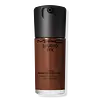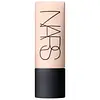Mac Cosmetics Studio Fix Fluid SPF 15 24HR Matte Foundation + Oil Control Versus NARS Cosmetics Soft Matte Complete Foundation
What's inside
What's inside
 Key Ingredients
Key Ingredients

 Benefits
Benefits

 Concerns
Concerns

 Ingredients Side-by-side
Ingredients Side-by-side

Water
Skin ConditioningMethyl Trimethicone
Skin ConditioningDimethicone
EmollientTrimethylsiloxysilicate
EmollientPEG-10 Dimethicone
Skin ConditioningButylene Glycol
HumectantIsododecane
EmollientPolyethylene
AbrasiveCetyl PEG/PPG-10/1 Dimethicone
EmulsifyingMagnesium Sulfate
Algae Extract
EmollientLaminaria Saccharina Extract
Skin ProtectingSodium Hyaluronate
HumectantSalix Nigra Bark Extract
Skin ProtectingTocopheryl Acetate
AntioxidantCaffeine
Skin ConditioningLecithin
EmollientHydrogenated Lecithin
EmulsifyingDisteardimonium Hectorite
StabilisingSilica
AbrasiveXanthan Gum
EmulsifyingDimethicone Crosspolymer
Emulsion StabilisingTriethoxycaprylylsilane
Dimethicone/PEG-10/15 Crosspolymer
Methoxy Amodimethicone/Silsesquioxane Copolymer
Skin ConditioningSorbitan Sesquioleate
EmulsifyingSalicylic Acid
MaskingSodium Citrate
BufferingLaureth-7
EmulsifyingMethyldihydrojasmonate
MaskingPropylene Carbonate
SolventAlumina
AbrasiveDipropylene Glycol
HumectantPentaerythrityl Tetra-Di-T-Butyl Hydroxyhydrocinnamate
AntioxidantBHT
AntioxidantPhenoxyethanol
PreservativeSorbic Acid
PreservativeChloroxylenol
AntimicrobialCI 77891
Cosmetic ColorantCI 77491
Cosmetic ColorantCI 77492
Cosmetic ColorantCI 77499
Cosmetic ColorantWater, Methyl Trimethicone, Dimethicone, Trimethylsiloxysilicate, PEG-10 Dimethicone, Butylene Glycol, Isododecane, Polyethylene, Cetyl PEG/PPG-10/1 Dimethicone, Magnesium Sulfate, Algae Extract, Laminaria Saccharina Extract, Sodium Hyaluronate, Salix Nigra Bark Extract, Tocopheryl Acetate, Caffeine, Lecithin, Hydrogenated Lecithin, Disteardimonium Hectorite, Silica, Xanthan Gum, Dimethicone Crosspolymer, Triethoxycaprylylsilane, Dimethicone/PEG-10/15 Crosspolymer, Methoxy Amodimethicone/Silsesquioxane Copolymer, Sorbitan Sesquioleate, Salicylic Acid, Sodium Citrate, Laureth-7, Methyldihydrojasmonate, Propylene Carbonate, Alumina, Dipropylene Glycol, Pentaerythrityl Tetra-Di-T-Butyl Hydroxyhydrocinnamate, BHT, Phenoxyethanol, Sorbic Acid, Chloroxylenol, CI 77891, CI 77491, CI 77492, CI 77499
Water
Skin ConditioningDimethicone
EmollientMethyl Methacrylate Crosspolymer
Trimethylsiloxysilicate
EmollientGlycerin
HumectantLauryl PEG-9 Polydimethylsiloxyethyl Dimethicone
Skin ConditioningSodium Chloride
MaskingBis-Butyldimethicone Polyglyceryl-3
CleansingOryza Sativa Bran Extract
Skin ConditioningHelianthus Annuus Extract
EmollientRosmarinus Officinalis Leaf Extract
AntimicrobialPlankton Extract
Skin ConditioningAlteromonas Ferment Extract
Skin ConditioningPEG-12 Dimethicone
Skin ConditioningPEG-10 Dimethicone
Skin ConditioningButylene Glycol
HumectantAluminum Hydroxide
EmollientPolysilicone-2
Disteardimonium Hectorite
StabilisingCI 77120
Cosmetic ColorantTocopherol
AntioxidantHydrogen Dimethicone
Sodium Acetylated Hyaluronate
HumectantAlumina
AbrasiveGlucose
HumectantHydrolyzed Pea Protein
EmollientSodium Succinate
BufferingPhenoxyethanol
PreservativeIron Oxides
CI 77492
Cosmetic ColorantCI 77499
Cosmetic ColorantMica
Cosmetic ColorantCI 77891
Cosmetic ColorantWater, Dimethicone, Methyl Methacrylate Crosspolymer, Trimethylsiloxysilicate, Glycerin, Lauryl PEG-9 Polydimethylsiloxyethyl Dimethicone, Sodium Chloride, Bis-Butyldimethicone Polyglyceryl-3, Oryza Sativa Bran Extract, Helianthus Annuus Extract, Rosmarinus Officinalis Leaf Extract, Plankton Extract, Alteromonas Ferment Extract, PEG-12 Dimethicone, PEG-10 Dimethicone, Butylene Glycol, Aluminum Hydroxide, Polysilicone-2, Disteardimonium Hectorite, CI 77120, Tocopherol, Hydrogen Dimethicone, Sodium Acetylated Hyaluronate, Alumina, Glucose, Hydrolyzed Pea Protein, Sodium Succinate, Phenoxyethanol, Iron Oxides, CI 77492, CI 77499, Mica, CI 77891
Ingredients Explained
These ingredients are found in both products.
Ingredients higher up in an ingredient list are typically present in a larger amount.
Alumina is another name for the compound aluminum oxide. It is used as a thickener, absorbent, and abrasive.
As an absorbent, alumina can give a mattifying effect. It is used in mineral sunscreens to help coat nano-sized filters, such as titanium dioxide. By increasing the size of the UV filters, these ingredients stay on the skin for a longer time. By coating small sized ingredients, alumina helps thicken a product.
Alumina may be used as an abrasive, or exfoliant.
Alumina is naturally occurring in the mineral corundum. Certain varieties of corundum create rubies and sapphires. Corundum is also the crystalline form of alumina.
Learn more about AluminaButylene Glycol (or BG) is used within cosmetic products for a few different reasons:
Overall, Butylene Glycol is a safe and well-rounded ingredient that works well with other ingredients.
Though this ingredient works well with most skin types, some people with sensitive skin may experience a reaction such as allergic rashes, closed comedones, or itchiness.
Learn more about Butylene GlycolCi 77492 is also hydrated iron III oxide. It's sole purpose is to give a yellow hue to products.
Iron III oxides are classified as inorganic chemicals for coloring.
Synthetically created Ci 77492 is considered safer than those naturally found. This is because the synthetically created version may contain less impurities. Iron oxides are generally non-toxic and non-allergenic.
Learn more about CI 77492Ci 77499 is also hydrated iron III oxide. It is created from mixing red and black iron oxides. This helps give shades of darkness to a product.
Iron III oxides are classified as inorganic chemicals for coloring.
Ci 77891 is a white pigment from Titanium dioxide. It is naturally found in minerals such as rutile and ilmenite.
It's main function is to add a white color to cosmetics. It can also be mixed with other colors to create different shades.
Ci 77891 is commonly found in sunscreens due to its ability to block UV rays.
Learn more about CI 77891Dimethicone is a type of synthetic silicone created from natural materials such as quartz.
What it does:
Dimethicone comes in different viscosities:
Depending on the viscosity, dimethicone has different properties.
Ingredients lists don't always show which type is used, so we recommend reaching out to the brand if you have questions about the viscosity.
This ingredient is unlikely to cause irritation because it does not get absorbed into skin. However, people with silicone allergies should be careful about using this ingredient.
Note: Dimethicone may contribute to pilling. This is because it is not oil or water soluble, so pilling may occur when layered with products. When mixed with heavy oils in a formula, the outcome is also quite greasy.
Learn more about DimethiconeDisteardimonium Hectorite comes from the clay mineral named hectorite. It is used to add thickness to a product.
It can also help stabilize a product by helping to disperse other ingredients.
Hectorite is a rare, white clay mineral.
Learn more about Disteardimonium HectoritePeg-10 Dimethicone is silicone with conditioner and emulsifier properties. It mostly acts as an emollient in skincare and and humectant in haircare.
According to the manufacturer, acidic formulations decrease the stability of this ingredient. It works best in neutral or near neutral formulations.
Phenoxyethanol is a preservative that has germicide, antimicrobial, and aromatic properties. Studies show that phenoxyethanol can prevent microbial growth. By itself, it has a scent that is similar to that of a rose.
It's often used in formulations along with Caprylyl Glycol to preserve the shelf life of products.
This silicone is an emollient. Emollients create a thin film on the skin to prevent moisture from escaping.
It is not soluble in water and helps increase water-resistance in products.
According to a manufacturer, it can blend seamlessly with silicone oils, such as Cyclopentasiloxane.
Learn more about TrimethylsiloxysilicateWater. It's the most common cosmetic ingredient of all. You'll usually see it at the top of ingredient lists, meaning that it makes up the largest part of the product.
So why is it so popular? Water most often acts as a solvent - this means that it helps dissolve other ingredients into the formulation.
You'll also recognize water as that liquid we all need to stay alive. If you see this, drink a glass of water. Stay hydrated!
Learn more about Water